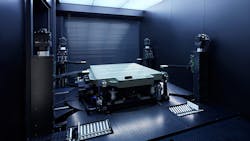EV Battery Swapping Revisited
What you’ll learn:
- Attempt by Lotus to have a hot-swappable-battery-capable EV available for LeMans by 2030.
- Success of automaker NIO’s battery-as-a-service (BaaS) model.
- China’s standardization efforts regarding battery swapping.
Lotus unveiled a design study focused an electric endurance racer—the goal is to have it compete at Le Mans and other tracks for the 2030 season. Among the Lotus E-R9’s projected innovations is an electric motor for each wheel and aircraft-like body panels that can change their shape as needed to deliver minimum drag on the straights and maximum downforce in the corners.
Of all the proposed features, it was most curious that the Lotus engineers chose to employ a hot-swappable battery that could be changed out by a pit crew, with a little mechanical help, in a similar manner to which fuel is replenished.
During a Le Mans race, a car will stop for fuel approximately every 45 minutes, around 30 times in all. This means a car needs to be able to do about 100 miles before refueling to be competitive. However, battery tech has only advanced to the point where it makes sense for shorter (about 45 minute) races, as in the current Formula E series. By 2030, Lotus reckons that the problem will be solved.
“Battery energy density and power density are developing significantly year on year. Before 2030, we’ll have mixed cell chemistry batteries that give the best of both worlds, as well as the ability to ‘hot-swap’ batteries during pitstops," said Louis Kerr, a member of the E-R9 development team and principal platform engineer for the Lotus Evija, a limited production electric sports car and the first EV to be introduced and manufactured by the company.
The notion that a car can be designed around the idea of hot-swappable batteries to allow for much faster “refueling” isn’t new. Indeed, in 2013, Elon Musk showed off Tesla's battery-swapping technology on its Model S. However, when Tesla opened a battery-swapping station in California, prepared to exchange a vehicle's energy cells for fully charged ones rather than rely on fast-charging stations, owners rejected the swapping-out battery concept. Only a small number of cars were being brought in to swap out batteries.
Successful Swapping in China
Nonetheless, the idea seems to be working in China, the largest EV market in the world with 3.1 million electric vehicles in active use. NIO, a publicly traded automaker founded in 2014 and based in Shanghai, is succeeding with a battery-swap business model. Clients of the Chinese brand can buy only the vehicle, choose BaaS (Battery as a Service), and select the best battery pack for their need: 70 kWh or the newer 100-kWh pack, for example.
Battery-swapping also raises the possibility that, as consumers will not own the battery—it will be leased until it’s swapped—automakers can reduce the overall cost of the EV. Batteries are one of the most expensive portions of an electric vehicle. For instance, NIO’s BaaS subscription model decouples the battery costs from the purchase price of its vehicles. Using the BaaS model, customers can buy the NIO ES8, ES6, or EC6 vehicles without a battery, rent batteries of different capacities, and pay the battery fee on a monthly basis in accordance with their actual needs.
NIO’s batteries-not-included program for its 70-kWh battery can save buyers $10,000 off the price of a vehicle. Currently, a 70-kWh pack is priced at about $145 per month.
Powered by a 100-kWh battery, the range of NIO models can now reach up to 615 km (382 miles). Purchasing a NIO car with the 100-kWh battery using BaaS results in an RMB 128,000 ($19,732) subtracted from the car’s price with a battery subscription fee of RMB 1,480 ($228) per month.
NIO has succeeded in a way no other automaker in the world has to date. Its EV battery-swap service in China, dubbed NIO Power, has surpassed 1.1 million exchanges. NIO has also expanded the size of its battery-swap network to 158, with plans to build 300 more in 2021 as the automaker has signed several agreements designed to expand this number even further.
For instance, NIO has an agreement with State Grid EV Service, a unit of China’s state-owned electricity distributor, to build 100 stations across China and a strategic cooperation agreement with a leading Chinese furniture retailer, Red Star Macalline, to jointly build EV charging and battery-swapping stations. Under the latter agreement, the two parties will co-build 60 such stations this year.
NIO built its first battery-swap station in May 2018. Each station has five spots for swappable batteries. It takes an average of three to five minutes to replace drained batteries with fully charged ones at a NIO Power Swap station. That's about the same time it takes to fill up on gasoline at a service station.
The Latest from NIO
At its NIO Day held in early January, the company launched its 150-kWh battery pack and second-generation battery swapping station.
The new battery pack boosts energy density to 360 Wh/kg thanks to a hybrid electrolyte, an inorganic Si/C composite anode, and a nano-coated high-nickel cathode. This battery would increase the range of the new ES8 to 850 km, the ES6 to 900 km, the EC6 to 910 km, and the ET7 to 1,000 plus km.
NIO's second-generation battery-swapping station can accommodate 13 batteries, allowing for up to 312 swap services per day. NIO said it expects the number of its battery-swapping stations in China to total 500 by the end of 2021. BaaS now covers 64 cities in China and NIO is building a new battery-swapping station in China every week.
Apart from NIO, BAIC BJEV, the electric-vehicle unit of Beijing Automotive Group (BAIC) and State Grid EV, a Chinese state-owned electric utility, are collaborating on the battery-swapping business with the aim of jointly setting up 100 battery-swapping stations and serving not fewer than 10,000 vehicles powered by swappable batteries before June 2021.
Governmental Role
One of the holdups on a full-blown attempt to make battery swapping widespread in China is that China's Ministry of Finance this year cut subsidies for EVs by 20%; the standard amount reimbursed to buyers last year was roughly RMB 18,000 ($2,800). That discount will now be reduced to around $2,220. Beijing’s subsidy support has a phase-out deadline of 2022.
To ensure a safe battery-swapping process, the Chinese government has been working on standardizing battery-swapping services, aiming to establish common industry standards for the procedure. This is important since the Chinese EV makers that provide battery-swapping services, including BJEV and NIO, have different battery models, which means that EV owners can only swap their batteries in their own brand's station.
The technical compliance required to serve multiple types of battery-powered vehicles is difficult. However, it can be overcome working with something like a taxi fleet in which all of the taxis are the same.
As a result, industry observers expect to see battery swapping take hold with robo-taxi and shared ownership fleets. For example, China's biggest maker of purely electric cars, BAIC BJEV, owns 206 battery-swap stations in 19 cities in China. The stations mainly serve the company's taxi fleet.
Similarly, Bluepark Intelligence Energy Technology Company, itself a battery-technology spinoff of the BAIC group of companies, is reported to have 187 battery-swap stations in 15 Chinese cities. The Bluepark battery-swapping operation caters mainly to the taxi population as well as to car sharing networks; it serves 16,000 electric powered taxis. One of the investors in BluePark Intelligence is SK Future Energy Shanghai, a wholly owned subsidiary of SK Innovation from Korea, which, in turn, is part of the Korean conglomerate SK Group.


